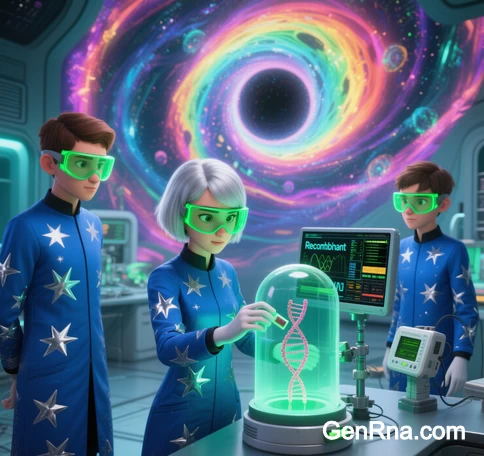 Core Conceptual Distinction
Core Conceptual Distinction
Recombinant DNA refers to artificially engineered DNA molecules created by combining genetic material from distinct biological sources (e.g., human genes inserted into bacterial plasmids). It is the physical product of genetic engineering.
DNA Cloning is the laboratory process of generating identical copies (clones) of a specific DNA sequence, often using recombinant DNA as a starting material. It is the technical methodology for amplification.
Suggested Figure: Side-by-side comparison: Recombinant DNA (chimeric plasmid with human insulin gene) vs. DNA cloning workflow (bacterial colonies growing on selective media).
1. Recombinant DNA: Design and Synthesis of Hybrid Molecules
A. Molecular Architecture
Recombinant DNA molecules are constructed using:
- Restriction Enzymes: Molecular scissors (e.g., EcoRI, HindIII) that cut DNA at specific palindromic sequences, generating compatible ends for ligation [1].
- DNA Ligase: Enzymatically fuses DNA fragments from disparate sources (e.g., mammalian gene + bacterial plasmid) [3].
- Vectors: Carrier molecules (plasmids, viral genomes) that host foreign DNA and enable replication in living cells [7].
B. Key Characteristics
- Chimeric Nature: Combines sequences evolutionarily unrelated (e.g., human growth hormone gene expressed in E. coli) [12].
- Purpose-Driven Design: Created to express proteins, edit genomes, or study gene function [2].
Suggested Figure: Structure of a recombinant plasmid: Labeled components include origin of replication (ORI), antibiotic resistance gene (Amp<sup>R</sup>), restriction sites, and inserted foreign DNA.
2. DNA Cloning: Amplification of Genetic Material
A. Stepwise Technical Workflow
- Ligation: Insertion of DNA fragment (e.g., PCR product) into a vector to create recombinant DNA.
- Transformation: Introduction of recombinant DNA into host cells (e.g., E. coli via heat shock or electroporation).
- Selection: Growth on antibiotic-containing media to identify successful transformants.
- Amplification: Host cell replication generates billions of identical DNA copies [6/14].
B. Core Objectives
- Mass Production: Generate abundant quantities of identical DNA for sequencing, mutagenesis, or protein expression [11].
- Preservation: Maintain stable genetic libraries for long-term study [15].
Suggested Figure: DNA cloning flowchart: From vector digestion to colony PCR screening.
3. Interdependence and Divergence
A. How They Interact
- Recombinant DNA serves as the input material for DNA cloning.
- DNA cloning is impossible without recombinant DNA when amplifying engineered sequences [9].
B. Critical Differences
| Parameter | Recombinant DNA | DNA Cloning |
|---|---|---|
| Nature | Molecular entity (product) | Technical process (methodology) |
| Primary Goal | Creation of novel genetic combinations | Replication of existing DNA sequences |
| Tools Required | Restriction enzymes, ligase, vectors | Host cells, growth media, PCR equipment |
| Output Examples | Plasmid expressing GFP, AAV vector for gene therapy | Bacterial colony with 10<sup>9</sup> plasmid copies |
Suggested Figure: Venn diagram illustrating overlap and unique aspects of recombinant DNA (design) vs. DNA cloning (amplification).
4. Applications Highlighting Their Roles
A. Recombinant DNA in Action
- Therapeutic Proteins: Human insulin production requires insertion of the INS gene into bacterial plasmids [1].
- CRISPR-Cas9 Systems: Guide RNA and Cas9 genes are combined into viral vectors for genome editing [2].
B. DNA Cloning in Practice
- Gene Libraries: Amplifying fragmented genomic DNA for whole-genome studies [13].
- Diagnostic Kits: Mass-producing labeled DNA probes for pathogen detection [15].
5. Historical Context and Evolution
- 1973: Cohen and Boyer created the first recombinant DNA molecule (frog rRNA gene + bacterial plasmid) [12].
- 1977: DNA cloning enabled large-scale production of somatostatin, the first recombinant protein [6].
- 2020s: Recombinant DNA designs now incorporate synthetic biology, while cloning leverages robotics for high-throughput screening [11].
Conclusion
Recombinant DNA and DNA cloning represent two inseparable yet distinct pillars of genetic engineering. Recombinant DNA is the engineered blueprint—a molecule born from human ingenuity to bridge evolutionary divides. DNA cloning is the industrial press—a replicative powerhouse that turns singular molecules into biological libraries. Together, they enable everything from life-saving biologics to evolutionary research. While recombinant DNA rewrites genetic narratives, DNA cloning ensures these narratives are archived, studied, and shared across scientific generations.
Data Source: Publicly available references.
Contact: chuanchuan810@gmail.com
